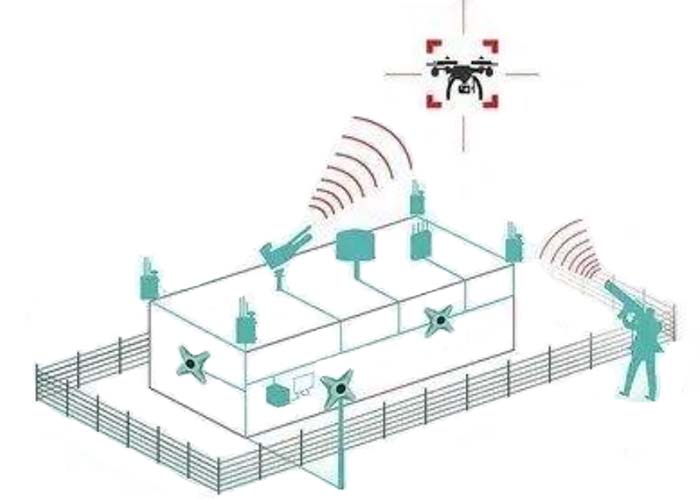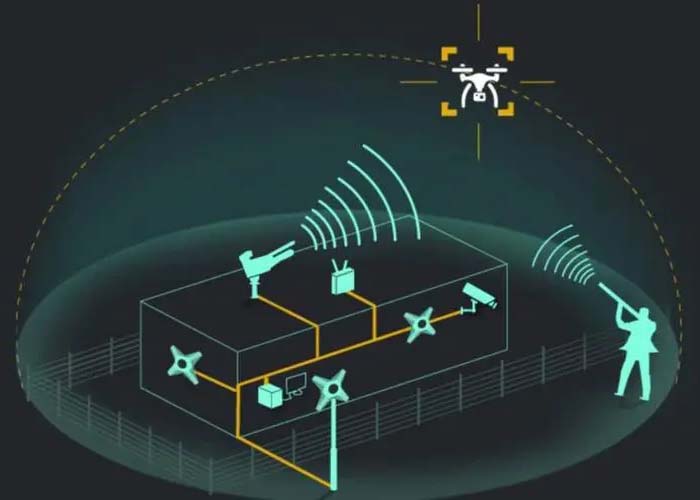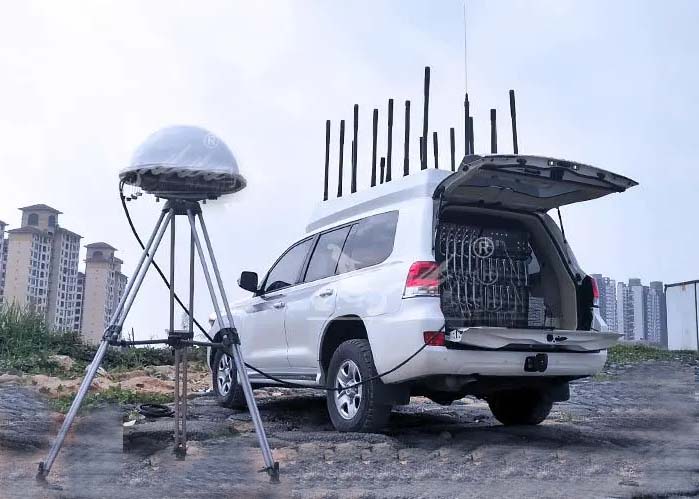What are drone anti-jamming systems?

The drone anti-jamming systems and anti-spoof technology protect against interference, jamming, and spoofing of the UAVs.
To protect their security, countries are beginning to research drone anti-jamming systems, also known as drone strike weapons. A drone strike weapon is a drone attack weapon that can attack and destroy enemy drones. So what is so unique about this amazing system?
According to scientists, the main components of a drone are wings, propellers, batteries, electronic controls, and other equipment. The systems of these drones are maneuvered by remote control. Therefore, drones must be aggressive to be used in drone combat.
Since drones are affected by terrain, obstacles, and weather when striking targets remotely, they need to have more than one eye to get optimal strikes and thus increase hit rates.
In addition, it should be equipped with rockets and even cruise missiles specifically designed to target small and light-fixed or moving targets.
The biggest advantage of drones is their flexibility, speed, and stealth. Suppose the drone is loaded with various kinds of explosives and uses GPS/GNSS to receive signals. In that case, it can find out the pre-buried detonation lines to carry out continuous bombing, which is enough to paralyze any fortifications and important facilities and give strong killings.
At the same time, relevant data is collected and transmitted back to the command room to prepare for the next decision.
There are many modified UAV products in the current market, for example, replacing ordinary cameras with radar, infrared thermal anti-jamming sensors, depth camera arrays, ultrasonic detectors, etc., which increases stability and reduces fuel consumption. In the future, drones will serve mankind better.
What is the principle of drone anti-jamming systems?
A drone is an aerial vehicle that has been widely used in various fields, such as aerial photography, agriculture, logistics, rescue, and so on, due to its flexibility and efficiency.
As the number of drones continues to increase, some illegal uses have begun to appear, such as the invasion of privacy or the use of drones for malicious purposes. Therefore, drone anti-jamming systems are becoming more and more important.
1. Electromagnetic jamming principle
By transmitting electromagnetic signals to the drone, it interferes with its communication or navigation system, causing it to lose control or be unable to fly correctly. This method usually uses electronic jammers or electromagnetic wave scramblers.
2. Optical jamming principle
By emitting light beams to the UAV, it interferes with its visual system, making it unable to recognize the target correctly or fly normally. This method usually uses laser beams or photoelectric jammers.
3. Mechanical Jamming Principle
By launching high-speed flying objects at the UAV, the UAV will be hit, causing it to lose balance or fall. This method usually uses UAV interceptors or UAV anchors.
4. Thermal Jamming Principle
Launching high or low-temperature substances at the drone, interferes with its power system or navigation system, making it unable to fly correctly. This method usually uses rockets or cryogenics.
It is important to note that the drone anti-jamming systems principle is not just a single tactic, but usually requires a combination of tactics to achieve the best anti-jamming results. At the same time, when conducting drone anti-jamming systems, it is also necessary to follow the relevant laws and regulations to avoid unnecessary legal disputes.
What are radar anti-jamming systems?

The radio spectrum monitoring system provides long-range detection of the UAV (effective discovery distance ≥3km), and the search radar provides long-range detection of the UAV (effective discovery distance ≥1.5km).
After the data fusion of the two detection data according to the use environment, the photoelectric tracking system is guided to realize the visualized tracking of the UAV, and finally, the RF jamming system shields the UAV’s flight control channel and navigation signals to drive away/forcibly land the UAV.
1. Radar anti-jamming system functions
1) The radar anti-jamming systems adopt passive detection technology to detect the radio signals from multiple targets in 360 degrees and locate the position of the targets according to the signals.
2) The radar anti-jamming systems adopt phased array radar detection technology, which can detect the position and speed information of multiple moving targets in 360 degrees;
3) The radar anti-jamming systems have visible light and infrared imaging functions, and can display visible light and infrared images of the alert area;
4) The radar anti-jamming systems have image detection, identification, and tracking functions.
5) The radar anti-jamming systems have a multi-band jamming function, capable of jamming the satellite navigation link, remote control link, and map transmission link of the UAV.
6) The radar anti-jamming systems can automatically/manually search and track the target according to the data from the search system.
7) The radar anti-jamming systems have a data storage function, which is convenient for investigation and evidence collection.
2.Radio monitoring and identification software functions
1) Receive UAV data detected by a radio antenna.
2) Process and analyze the data, and get the angle, distance, and model of the drone according to the radio data processing algorithm and database.
3) With display and operation interface, displaying the relevant information of the equipment and target for the operator’s use.
4) Make relevant settings according to the environment to improve the capturing ability.
3.Radar monitoring and identification software functions
1) Receive the UAV data detected by the radar antenna.
2) Process and analyze the data, and get the angle, distance, and trajectory of the UAV according to the radar data processing algorithm.
3) With display and operation interface, displaying equipment and target-related information for the operator to use.
4) Make relevant settings according to the environment to reduce the false alarm rate and improve the capturing ability.
Drone anti-jamming systems for prison application
Drones continue to be one of the most destructive technologies of the last decade. As they have entered the mainstream public eye, people have begun to utilize the technology and misuse drones.
Prisons face the challenge of smugglers using drones to transport drugs, weapons, cell phones, and other contraband onto facility grounds.
Prisons are secure units where people are restricted from committing crimes. Communication and interaction with the outside world is limited. Certain everyday items such as cell phones, tobacco, and cigarettes are banned or restricted, and other items such as drugs, razors, etc. are prohibited.
What can prisons do when faced with these types of problems?
There are options for drone defense systems that work 24/7.
Prisons can integrate a drone anti-jamming system into their area-based alert system for consistent and complete surveillance of their perimeter, airspace, and centralized facilities.
Its alarms provide advanced warnings of drone activity and can be configured to automatically disrupt drones entering a specified perimeter.
The Drone Anti-jamming Systems are installed near external and internal perimeters that you can maintain remotely. They contain a database of drone acoustic signatures typically used for smuggling and links to a browser-based interface that lets you view local acoustic activity in real-time.
As soon as a drone is detected, the Anti-jamming Systems send out an immediate alert via text message, email, or your existing alarm system, and can automatically disrupt an unauthorized drone within seconds.
What can drone anti-jamming systems do

The drone anti-jamming systems can do the below jobs.
Implement early warning against black-flight drones;
Can disrupt incoming drones forcing them to lower to the ground or return to the operator, allowing law enforcement to intervene;
Contribute to more comprehensive surveillance by monitoring the airspace and ground perimeter;
Complements and integrates with existing security systems for rapid enforcement;
Retain data from alerts for use as digital evidence in legal proceedings;
Etc.
What technology is used to jamming drones?
Drone anti-jamming systems are so powerful, what technology does it use? The main functions and features of the anti-jamming drone systems:
1. Types of drones that the system detects and jams against
The detection objects of this system include all kinds of drones within the frequency band of 2.4GHz/5.8GHz/130~3000MHz.
The target of jamming includes all kinds of UAVs within the range of 2.4GHz and 5.8GHz frequency bands and can be extended to UAV targets within the range of 130~3000MHz frequency bands through the later stage.
2. Radio jamming strike capability
The maximum jamming power reaches 150W, and the farthest jamming radius reaches more than 1.6km.
Adopting omni-directional jamming mode, it can carry out jamming strikes on all targets in the jamming range; the jamming signal objects include uplink remote control signals, downlink telemetry, and map transmission signals of UAVs working in 2.4GHz, 5.8GHz, 1.5GHz, 433MHz, 868MHz, and 915MHz frequency bands.
It can also add 315MHz, 1.2GHz, 1.4GHz, 1.8GHz, 2.1GHz, 2.3GHz, 2.6GHz, 3.5GHz, 5.15GHz, and so on.
3.Drone anti-jamming system working mode and working mode
The drone anti-jamming systems adopt a fully automated, intelligent, 7x24h unattended working mode.
Specifically can be set to use one of the four working modes.
Full-automatic mode (detection and jamming without any manual participation, as the main working mode);
Semi-automatic mode (automatic detection and identification, but inquiries before the jamming strike, manually determined by the implementation of the jamming strike);
Clearance mode (uninterrupted continuous scanning jamming of the entire perimeter or designated angle airspace, which can effectively prevent drones working with radio from taking off from and flying into no-fly zones, defense zones, or alert zones);
Manual mode (detection, identification, and jamming strikes are all operated manually, and this mode is mainly implemented by technical experts);
4. Scalability and openness
The drone anti-jamming systems have a good scalability, according to the needs of the late addition of equipment to achieve stronger functions.
(For example, the ability to combat interference in the 130-3000MHz frequency band other than 2.4GHz/5.8GHz; optical surveillance, radar detection, and other monitoring methods: the ability to monitor and discover other types of unmanned aerial vehicles that do not use radio).
The drone anti-jamming systems have a good openness and can interface with other systems of the user according to their needs and push important information to them.
How to anti-jamming drones
At present, drone anti-jamming systems mainly use four methods, of which, interference blocking is the most important means, by interfering with the communication or hardware of the drone, it can force the drone to return to the flight automatically or land automatically. The other three methods are deception control, interception capture, and direct destruction.
1.Interference blocking
(1) Electromagnetic jamming
Electromagnetic jamming can effectively block the communication between the UAV and the control station, cut off the UAV’s remote control signals, as well as digital and graphic signals, and achieve the purpose of forcing the UAV to land or drive it away. Electromagnetic jamming is directional or omni-directional jamming, effectively dealing with multiple UAVs within the action distance.
(2) Navigation signal jamming
The UAV generally utilizes the satellite navigation and positioning system to locate itself, and the implementation of navigation signal jamming can cause the UAV to be unable to accurately locate itself, thus affecting the UAV’s flight control system and restricting the UAV’s flight.
(3) Acoustic wave jamming
This is an expensive jamming method. The UAV maintains its balance through the feedback information of the gyroscope and the control system.
Control system to maintain its balance. Acoustic jamming can send out sound waves with the same frequency as that of the gyroscope, causing the drone to experience the gyroscope, causing it to resonate, and preventing the gyroscope on the UAV from working properly.
2.Deception control
(1) Navigation signal deception
The launch of false navigation satellite signals to “deceive and confuse” the UAV, so that the UAV mistakenly believes that its target is a false position preset by the system.
Since the satellite navigation signals received by the UAV are weak, the system only needs a small amount of transmit power to realize the deception effect on the UAV.
(2) Radio signal hijacking
This method involves first cracking the communication protocol of the drone signal and then sending a control signal with a stronger signal to the drone, thus controlling the drone.
3.Interception and Capture
Intercepting and capturing from the ground or the air, mainly using launching guns to shoot capture nets, or employing large drones to capture small drones, in addition, there are also training eagles to capture drones and bring them to designated areas.
4.Direct Destruction
Missiles, laser weapons, microwave weapons, etc. are all capable of attacking drones. However, these methods have more various constraints and can also lead to the crash of the drone. Therefore, direct destruction is suitable for use in suburban and field environments and is not suitable for urban environments.
Besides this What Are Anti-Jamming Systems article, you may also be interested in the below articles.
4G vs 5G: What is the difference between 4G and 5G?
How to Choose the Best Antenna for Lora?
